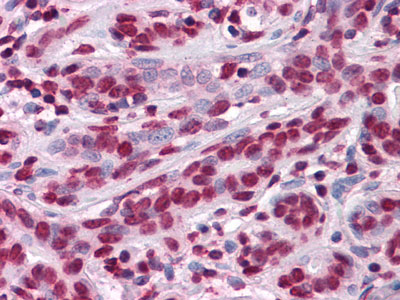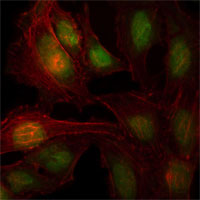ZBTB7B Antibody
Purified Mouse Monoclonal Antibody
- 产品详情
- 实验流程
Application
| WB, IHC, ICC, E |
|---|---|
| Primary Accession | O15156 |
| Reactivity | Human |
| Host | Mouse |
| Clonality | Monoclonal |
| Clone Names | 7C12 |
| Isotype | lgG1 |
| Calculated MW | 58027 Da |
| Description | ZBTB7B is a transcription regulator that acts as a key regulator of lineage commitment of immature T-cell precursors. It is necessary and sufficient for commitment of CD4 lineage, while its absence causes CD8 commitment. Development of immature T-cell precursors (thymocytes) to either the CD4 helper or CD8 killer T-cell lineages correlates precisely with their T-cell receptor specificity for major histocompatibility complex class II or class I molecules, respectively. ZBTB7B is a transcriptional repressor of the collagen COL1A1 and COL1A2 genes. It may also function as a repressor of fibronectin and possibly other extracellular matrix genes. |
| Immunogen | Purified recombinant fragment of human ZBTB7B expressed in E. Coli. |
| Formulation | Ascitic fluid containing 0.03% sodium azide. |
| Gene ID | 51043 |
|---|---|
| Other Names | Zinc finger and BTB domain-containing protein 7B, Krueppel-related zinc finger protein cKrox, hcKrox, T-helper-inducing POZ/Krueppel-like factor, Zinc finger and BTB domain-containing protein 15, Zinc finger protein 67 homolog, Zfp-67, Zinc finger protein 857B, Zinc finger protein Th-POK, ZBTB7B, ZBTB15, ZFP67, ZNF857B |
| Dilution | WB~~1/500 - 1/2000 IHC~~1/200 - 1/1000 ICC~~N/A E~~N/A |
| Storage | Maintain refrigerated at 2-8°C for up to 6 months. For long term storage store at -20°C in small aliquots to prevent freeze-thaw cycles. |
| Precautions | ZBTB7B Antibody is for research use only and not for use in diagnostic or therapeutic procedures. |
| Name | ZBTB7B (HGNC:18668) |
|---|---|
| Synonyms | ZBTB15, ZFP67, ZNF857B |
| Function | Transcription regulator that acts as a key regulator of lineage commitment of immature T-cell precursors. Exerts distinct biological functions in the mammary epithelial cells and T cells in a tissue-specific manner. Necessary and sufficient for commitment of CD4 lineage, while its absence causes CD8 commitment. Development of immature T-cell precursors (thymocytes) to either the CD4 helper or CD8 killer T-cell lineages correlates precisely with their T-cell receptor specificity for major histocompatibility complex class II or class I molecules, respectively. Cross-antagonism between ZBTB7B and CBF complexes are determinative to CD4 versus CD8 cell fate decision. Suppresses RUNX3 expression and imposes CD4+ lineage fate by inducing the SOCS suppressors of cytokine signaling. induces, as a transcriptional activator, SOCS genes expression which represses RUNX3 expression and promotes the CD4+ lineage fate. During CD4 lineage commitment, associates with multiple sites at the CD8 locus, acting as a negative regulator of the CD8 promoter and enhancers by epigenetic silencing through the recruitment of class II histone deacetylases, such as HDAC4 and HDAC5, to these loci. Regulates the development of IL17-producing CD1d-restricted naural killer (NK) T cells. Also functions as an important metabolic regulator in the lactating mammary glands. Critical feed-forward regulator of insulin signaling in mammary gland lactation, directly regulates expression of insulin receptor substrate-1 (IRS-1) and insulin-induced Akt-mTOR-SREBP signaling (By similarity). Transcriptional repressor of the collagen COL1A1 and COL1A2 genes. May also function as a repressor of fibronectin and possibly other extracellular matrix genes (PubMed:9370309). Potent driver of brown fat development, thermogenesis and cold-induced beige fat formation. Recruits the brown fat lncRNA 1 (Blnc1):HNRNPU ribonucleoprotein complex to activate thermogenic gene expression in brown and beige adipocytes (By similarity). |
| Cellular Location | Nucleus {ECO:0000250|UniProtKB:Q64321}. |
Research Areas
For Research Use Only. Not For Use In Diagnostic Procedures.
Application Protocols
Provided below are standard protocols that you may find useful for product applications.
REFERENCES
1.Proc Natl Acad Sci U S A. 1994 Sep 27;91(20):9372-6. 2.J Biol Chem. 2000 Sep 1;275(35):27421-38. 3.J Cell Biochem. 2009 Aug 15;107(6):1037-45. Review.
终于等到您。ABCEPTA(百远生物)抗体产品。
点击下方“我要评价 ”按钮提交您的反馈信息,您的反馈和评价是我们最宝贵的财富之一,
我们将在1-3个工作日内处理您的反馈信息。
如有疑问,联系:0512-88856768 tech-china@abcepta.com.























 癌症的基本特征包括细胞增殖、血管生成、迁移、凋亡逃避机制和细胞永生等。找到癌症发生过程中这些通路的关键标记物和对应的抗体用于检测至关重要。
癌症的基本特征包括细胞增殖、血管生成、迁移、凋亡逃避机制和细胞永生等。找到癌症发生过程中这些通路的关键标记物和对应的抗体用于检测至关重要。 为您推荐一个泛素化位点预测神器——泛素化分析工具,可以为您的蛋白的泛素化位点作出预测和评分。
为您推荐一个泛素化位点预测神器——泛素化分析工具,可以为您的蛋白的泛素化位点作出预测和评分。 细胞自噬受体图形绘图工具为你的蛋白的细胞受体结合位点作出预测和评分,识别结合到自噬通路中的蛋白是非常重要的,便于让我们理解自噬在正常生理、病理过程中的作用,如发育、细胞分化、神经退化性疾病、压力条件下、感染和癌症。
细胞自噬受体图形绘图工具为你的蛋白的细胞受体结合位点作出预测和评分,识别结合到自噬通路中的蛋白是非常重要的,便于让我们理解自噬在正常生理、病理过程中的作用,如发育、细胞分化、神经退化性疾病、压力条件下、感染和癌症。








